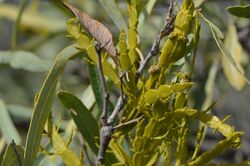Biology:Korthalsella rubra
| Korthalsella rubra | |
|---|---|

| |

| |
| Korthalsella rubra on Atalaya hemiglauca | |
| Scientific classification | |
| Kingdom: | Plantae |
| Clade: | Tracheophytes |
| Clade: | Angiosperms |
| Clade: | Eudicots |
| Order: | Santalales |
| Family: | Santalaceae |
| Genus: | Korthalsella |
| Species: | K. rubra
|
| Binomial name | |
| Korthalsella rubra | |
Korthalsella rubra (common name - Jointed mistletoe)[3] is a flowering plant in the Santalaceae (sandalwood) family,[4] formerly placed in the Viscaceae.
Description
It grows to about 16 cm,[5] and has distinctive green to yellow-green segmented branches which are flattened. The minute flowers are found within cushions at the nodes between the segments, separating into the edges as the segments grow larger.[6]
Distribution
It is found in eastern Australia from Gippsland (Victoria) to Cape York (Queensland).[6]
Ecology
It is a host plant for the butterfly, Delias nysa,[6] and can be found on some 25 or more different host species.[7][8]
Taxonomy
It was first described as Bifaria rubra by Philippe Édouard Léon Van Tieghem in 1896.[9][10] In 1897, Adolf Engler assigned it to the genus, Korthalsella, renaming it, Korthalsella rubra.[1][2] This taxonomy is accepted by the CHAH, but others[11] consider it a synonym of Korthalsella japonica f. rubra (Tiegh.) Molvray.
Australian taxonomic sources accept two subspecies, Korthalsella rubra (Tiegh.) Engl. subsp. rubra,[12][5][3] and Korthalsella rubra subsp. geijericola Barlow.[13][5]
References
- ↑ 1.0 1.1 "Korthalsella rubra". Australian Plant Name Index (APNI), IBIS database. Centre for Plant Biodiversity Research, Australian Government. https://biodiversity.org.au/nsl/services/rest/name/apni/115532.
- ↑ 2.0 2.1 Engler, H.G.A. in Engler, H.G.A. & Prantl, K.A.E. (1897) Naturlichen Pflanzenfamilien. Nachträge zum II bis IV Teil (157-8): 138.
- ↑ 3.0 3.1 Statjsic, V. (2019) VicFlora Flora of Victoria: Korthalsella rubra (Tiegh.) Engl. from Jeanes, J.A. (1999) Viscaceae. In: Walsh, N.G.; Entwisle, T.J. (eds), Flora of Victoria Vol. 4, Cornaceae to Asteraceae. Inkata Press, Melbourne.
- ↑ Govaerts, R. et al. (2019) Plants of the world online: Korthalsella. Board of Trustees of the Royal Botanic Gardens, Kew. Retrieved 26 March 2019.
- ↑ 5.0 5.1 5.2 Quirico, A.L. New South Wales Flora online: Korthalsella rubra (Tiegh.) Engl. National Herbarium of NSW, Royal Botanic Garden, Sydney, Australia. Retrieved 26 March 2019.
- ↑ 6.0 6.1 6.2 Watson, D.M. (2011) Mistletoes of Southern Australia. CSIRO Publishing, Collingwood, Victoria. ISBN:9780643095939
- ↑ Downey, PO (1998) An inventory of host species for each aerial mistletoe species (Loranthaceae and Viscaceae) in Australia. Cunninghamia 5, 685-720.
- ↑ Downey, PO (2004) A regional examination of the mistletoe host species inventory. Cunninghamia 8, 354-361.
- ↑ Van Tieghem, M. Ph. (2014). "Sur Le Groupement Des Espèces En Genres Dans Les Ginalloées, Bifariées, Phoradendrées Et Viscées, Quatre Tribus De La Famille Des Loranthacées". Bulletin de la Société Botanique de France 43 (3): 173. doi:10.1080/00378941.1896.10830658. ISSN 0037-8941. https://zenodo.org/record/1604917.
- ↑ "Bifaria rubra". Australian Plant Name Index (APNI), IBIS database. Centre for Plant Biodiversity Research, Australian Government. https://biodiversity.org.au/nsl/services/rest/name/apni/456830.
- ↑ Govaerts, R. et al. (2019) Plants of the world online: Korthalsella rubra. Board of Trustees of the Royal Botanic Gardens, Kew. Retrieved 26 March 2019.
- ↑ "Korthalsella rubra (Tiegh.) Engl. subsp. rubra". Australian Plant Name Index (APNI), IBIS database. Centre for Plant Biodiversity Research, Australian Government. https://biodiversity.org.au/nsl/services/rest/name/apni/115560.
- ↑ "Korthalsella rubra subsp. geijericola Barlow". Australian Plant Name Index (APNI), IBIS database. Centre for Plant Biodiversity Research, Australian Government. https://biodiversity.org.au/nsl/services/rest/name/apni/115552.
External links
Wikidata ☰ Q18076686 entry
 |

